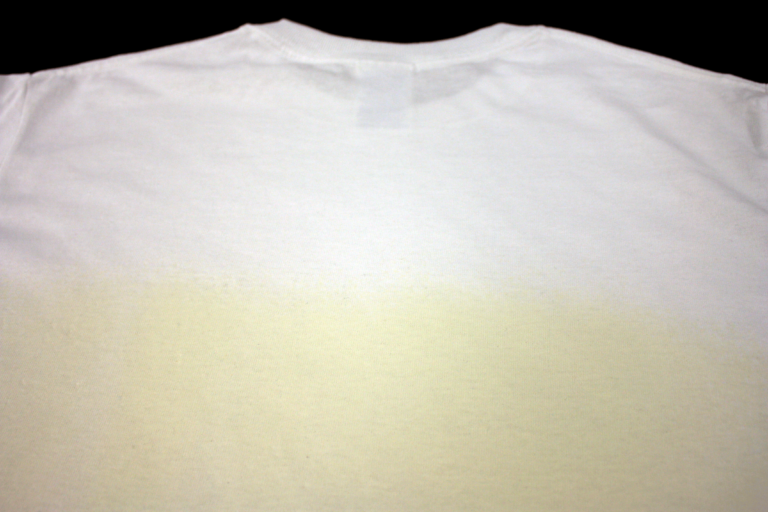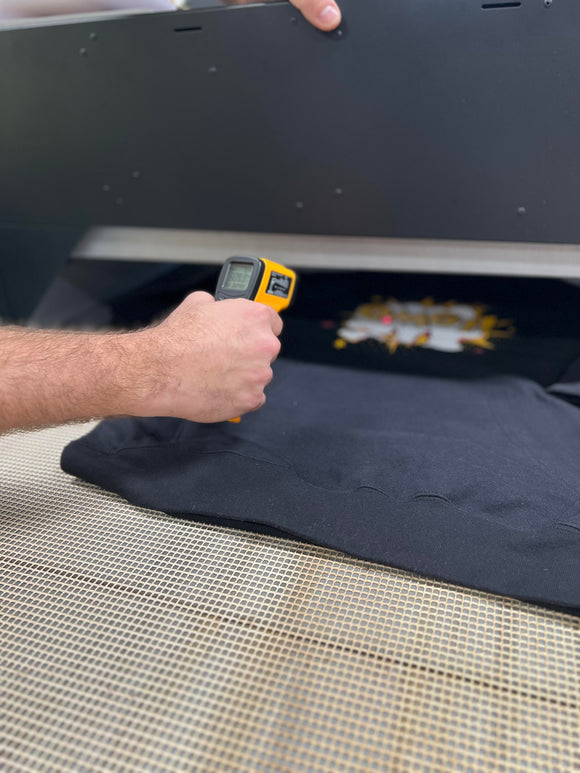
Why is My Pretreated Shirt Staining?
Ruby Dann
Many DTG shops run into the same issue; shirts stain anywhere that pretreatment was applied. Here at FIREBIRD, we’ve taken some big steps towards eliminating this issue with our FBX-100 stain resistant pretreatment as well as our T-Shirt Matrix of suggested shirts. Despite this, we still hear questions from our users about shirts becoming ruined. These issues are easy to fix, and below you can find a guide on some of the pitfalls that you may come across while printing.
Why Pretreatment Stains on the Heat Press
The most common issues that we hear about are stains, burns, and discoloration becoming visible immediately after the shirt comes off of the heat press. Fortunately, these are typically the easiest issues to fix. When you see a shirt begin to discolor, the heat and pressure are most likely too high. FIREBIRD Pretreatment should not be pressed dry above 330 degrees and only needs a low amount of pressure.
If you’ve already lowered the heat and pressure on your press, it may be that you are applying more pretreatment than you need. This is the most likely to happen when using a hand sprayer, which makes it almost impossible to gauge how much that you have applied to a shirt. The needed amount of pretreat depends on a number of variables, including the color, weave of the shirt, and what you’re trying to print, so you will need to pay attention to what works best for your shop. You may come across this issue when Teflon sheets and heat presses become sticky with pretreatment. As you press shirts, a bit of pretreat will stick to the surface and may accidentally be applied on the next shirt, causing stains and some “halo” effects. We suggest using disposable silicon treated paper to prevent the worst of this effect.
Why Shirts Form Crystals
A less common issue that you may see is what we call “crystallization”. Instead of the shirt changing colors the way that is common with typical staining, the pretreated area may look like there is salt on the shirt. This is caused by water in the pretreatment becoming trapped while the shirt is being pressed. You are most likely to see this when using too much pressure or a poor quality sheet of parchment paper.
The surest fix for this is to use a hover technique when pressing the shirt. To do this, first lower the press so that it is hovering just above the shirt for ten seconds. After this, lift the press to allow steam to escape. You may now continue pressing the shirt as you normally would. If your press does not allow for you to hover, then you may instead try pressing for several short intervals. You should still see steam escape the shirt when the press is lifted, which will prevent water from building up and causing issues.
Staining in the Sun
Occasionally, a customer may purchase a shirt, only to bring it back later when it stains after being worn. On sports grey, heathered grey, and white shirts this may happen after exposure to direct sunlight when using FBX-100. This sun staining effect happens on every shirt, but most garments are too dark for the effect to be seen.
This stain will not wash out, and is best resolved by avoiding it altogether. FBX-VIVID will not stain in the sun, and will improve wash results and vibrancy on any print that does not need white ink. Even designs the require the “pop” provided by a white ink underbase will work best with FBX-VIVID. For the designs that do need white ink on these colors, washing the shirt before wearing it outside will prevent this issue. The amount of pretreatment will not change the amount of sun staining that you see.
Miscellaneous Issues
Of course, some shirts will have issues that are a bit more unique. Veteran t-shirt printers will already know that red shirts tend to discolor when hot, only to return to their correct shade after cooling off. Some blue shirts are more likely to stain and you may need to drastically lower your pressure and temperature. We suggest using our T-Shirt Matrix as a guide for which shirts are more likely to cause problems.
An unfortunate truth of Direct To Garment printing is that any shirt with a polyester content is more likely to stain when pressed. DTG focuses on 100% cotton garments, and it can be difficult to print dark colored polyester and blended shirts. While some users avoid these materials altogether, others have found success using FBX-100 by pressing the shirt in intervals. This allows the pretreatment to dry and ink to cure without letting the shirt become hot enough to burn. Unfortunately, these fabrics are produced differently between brands and results are inconsistent.
For any questions not covered or more details on your specific issue, please give us a call at 203-306-2988. We’re also available by email at ink@firebirdink.com.


